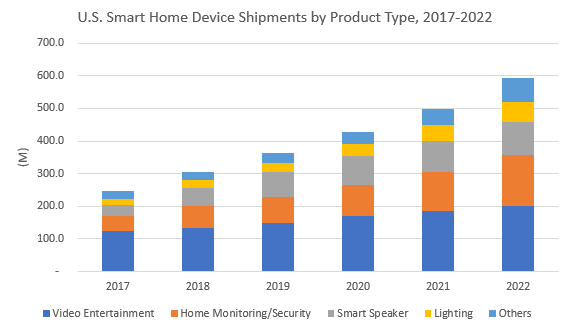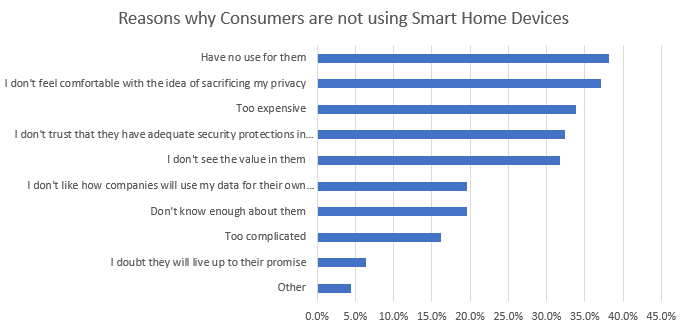Seven years ago, I embarked on my smart home journey, although I didn’t know it at the time. Being an avid gamer and student in college, I subscribed to a broadband internet service and setup my wireless home network. This allowed me to compete in online video games through my gaming console, connect my laptop to the internet, and stream movies on my tablet. What I didn’t realize back then was that I had just laid the necessary infrastructure in my home to support a lifestyle of comfort, convenience, security, and cost savings that I would come to enjoy seven years later.
Today my smart home consists of a rich ecosystem of Internet of Things (IoT) devices – including five smart speakers, four smart thermostats, three streaming media players, two smart cameras, one robot vacuum, and a bevy of internet-connected light bulbs – that collectively make my life more organized, informed, entertained, secure, and save my household money.
My smart thermostats respond to my habits and adjust accordingly, saving me money and reducing my energy consumption. I have peace of mind that my packages won’t be stolen from my front door thanks to my smart cameras. In the basement, a robot vacuum cleaner allows me to exercise in comfort without stepping in cat litter every day. When I frequently forget to turn the lights off in my home office, I can simply open an app on my phone and turn them off without having to walk up three flights of stairs, and even set a schedule to turn them off automatically. I save money on my cable bill by choosing a basic package and instead stream most of my TV shows and movies through my streaming sticks and video game consoles. Most importantly, my experiences with all these devices are dramatically enhanced by my smart speakers, through which I use my smart assistant to access services and control everything with just my voice.
In light of all the benefits I enjoy from having a smart home today, however, my journey has not been easy, and I find myself wanting more. Not just more devices, which would be nice, but more richer experiences where my devices can all communicate with each other and adjust according to my preferences, habits, and interactions of other devices. Like many consumers, I have found it has been an expensive and complex journey thus far, and I’m finding it increasingly difficult to justify the costs to push my smart home to the next level. For example, to equip all the lights in my home with smart bulbs will cost several hundreds of dollars. I also worry about my privacy and the security of my devices, and as both an industry analyst and consumer I find myself wondering: what’s holding others back from embarking on their own smart home journeys, and what’s stopping those that already have from moving to the next level?
The Smart Home Market by The Numbers
IDC’s recent smart home forecast shows the total number of smart home device shipments reaching 306.2 million units by the end of 2018, and up to 591.9 million devices by the end of 2022. This includes devices ranging from smart lights, thermostats, and speakers, to home monitoring and security devices, video entertainment devices, appliances, and others. The market for these devices is still in its early days, however, with IDC’s recent Consumer IoT Survey indicating that only two in five respondents that have a wireless home network engage with at least one home automation, monitoring and control application.

Streaming video from the internet to the television remains a key stepping-stone for consumers in the evolution of their digital homes, moving from connected computing and communication devices to connected entertainment devices. Generally, consumers take on networked video entertainment applications, such as streaming online video to the television, before adopting home automation, video monitoring, and control applications. This segment currently represents the largest share of the volume of smart home device shipments each year and today accounts for almost half of the market. Given that broadband penetration for US households is nearing saturation, and networked video entertainment devices are much sought-after, what’s holding consumers back from pushing adoption rates higher for other devices?
Leading Barriers to Smart Home Adoption
IDC’s Consumer IoT Survey indicates that a perceived lack of need and value, concerns about privacy and security, and costs are the top concerns keeping them from translating interest in smart home applications into actually purchasing home IoT devices – issues that have dampened the category since its inception.

Source: IDC’s Consumer Internet of Things Survey, June 2018 (N=296)
Security and privacy are undoubtedly major concerns for most consumers. Top privacy concerns center around information collection and sharing without permission, while leading security concerns focus on identity theft and unauthorized control of devices. Most consumers are generally unhappy or unsure about sharing information with first-party device makers; but the majority of them are decidedly against sharing information with third-party companies and organizations. Among consumers that are not concerned about security, there is a high degree of comfort and trust in protections to remedy any security breach. Perhaps not surprisingly, the intensity of privacy and security concerns increases with age, peaking for those aged 55-64, and the willingness to share information or data with vendors and third-parties is strongest for millennials, high income households, and males.
The Journey Ahead for Consumers and Vendors
The road ahead for consumers in their smart home evolutions is paved with both promise and uncertainty. There is much to be gained from deploying smart home devices that can make a household more efficient in time, energy, and costs. But the threat of security breaches and having to sacrifice privacy – not to mention the total costs involved with deploying IoT-enabled devices – will continue to inhibit the market’s growth for the foreseeable future.
On the supply side of the market, smart home device makers and service providers need to:
- Demonstrate clear value by showing consumers the ways in which connected devices can work in concert to bring about newfound conveniences
- Be mindful that consumers are sensitive to prices, security, and privacy issues
- Remove the complexity and uncertainty that surround smart home ecosystems, build trust, and tailor their marketing efforts to the right audience
On the demand side, consumers need to:
- Do more to explore the ways in which smart home devices can enrich their lives by researching companies and products to make informed decisions
- Talking to friends and family members that are further along in their smart home journeys can be a helpful way to better understand which products best meet their own needs
Want to learn more about the IoT market as a whole? Tune in to IDC’s IoT Market Update, presented on August 30, 2018.




